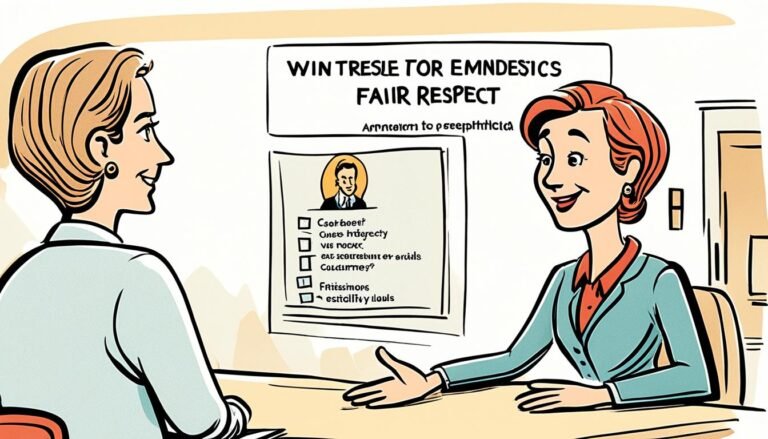Anchoring Effect Tactics in Price Talks
When it comes to price negotiations, understanding the psychology behind pricing strategies is essential. One powerful cognitive bias that often comes into play is the anchoring effect. This bias refers to the tendency for individuals to give too much weight to the first number proposed, known as the anchor. This can significantly impact the outcome of negotiations and influence the perception of value.
By recognizing and defusing the anchor, negotiators can navigate price talks with confidence and achieve favorable results. It’s important to respond to an anchor with a counter offer only after defusing its influence and providing a clear explanation for the fairness of the new proposal. Additionally, the midpoint rule can serve as a guiding principle, indicating that negotiations often converge towards the midpoint between the initial offer and counteroffer.
Key Takeaways:
- The anchoring effect is a cognitive bias where individuals give excessive weight to the first number proposed in negotiations.
- Defusing the anchor is crucial and involves rejecting the initial proposed number and justifying why it is unacceptable.
- The midpoint rule suggests that the final deal price often falls near the midpoint between the initial offer and counteroffer.
- Understanding the anchoring effect can enable negotiators to guide pricing decisions and optimize outcomes.
- Using anchoring tactics ethically and transparently is essential for maintaining trust and avoiding unethical pricing practices.
Understanding the Anchoring Effect in Negotiations
The anchoring effect is a cognitive bias that significantly influences decision-making in negotiations. Individuals tend to heavily rely on the first piece of information presented to them, known as the anchor, when making judgments and setting expectations. In the context of pricing negotiations, this bias can have a profound impact on the outcome.
Negotiators who possess a deep understanding of the anchoring effect can strategically use anchoring tactics to influence pricing decisions in their favor. By leveraging this cognitive bias, negotiators can guide their counterparts towards more favorable pricing options.
Setting Specific and Challenging Goals
One effective anchoring tactic is to set specific and challenging goals during negotiations. By presenting a higher initial price, negotiators can anchor the counterpart’s expectations to a higher range. This approach increases the likelihood of achieving a better outcome by steering the negotiation towards a higher final price point.
Power of Suggestion
The power of suggestion is another powerful tool in utilizing the anchoring effect. Negotiators can strategically influence pricing decisions by making subtle suggestions that favor their desired outcome. For example, highlighting the unique features of a particular pricing option or labeling it as the “recommended” choice can anchor the counterpart’s decision-making towards a specific option, ultimately influencing the pricing decision.
Avoiding Extremes in Pricing Options
When presenting pricing options, it is important to avoid extreme values. Customers tend to avoid both the highest and lowest prices, making the middle range more attractive. By strategically positioning the desired pricing option within this range, negotiators can anchor the counterpart’s perception of value and increase the likelihood of acceptance.
- In negotiations, the anchoring effect is a cognitive bias in which individuals rely heavily on the first piece of information provided.
- Negotiators can use anchoring tactics to guide pricing decisions in their favor.
- Setting specific and challenging goals, using the power of suggestion, and avoiding extremes in pricing options are effective strategies.
“The anchoring effect is a powerful psychological bias that can significantly influence pricing negotiations. By understanding and utilizing anchoring tactics effectively, negotiators can steer the conversation towards favorable outcomes.”
Defusing the Anchor in Price Negotiations
The anchoring effect is a powerful cognitive bias that can significantly impact price negotiations. To achieve a favorable outcome, it is essential to defuse the anchor presented by the other party and establish a new baseline for negotiations.
Defusing the anchor involves clearly and assertively rejecting the initial proposed price and providing a compelling explanation as to why it is unacceptable. By doing so, negotiators prevent the other party from assuming that the initial price falls within the bargaining zone.
“The key to defusing the anchor is to clearly communicate that the initial price is unreasonable and explain why it doesn’t align with market standards or the value being offered.”
After defusing the anchor, it is crucial to quickly present a counterproposal. This counterproposal should be well-reasoned and supported by a logical explanation of its fairness. By justifying the counteroffer, negotiators can help the other party understand the value they are providing and increase the chances of reaching a mutually beneficial agreement.
Defusing the Anchor Tactics:
To effectively defuse the anchor, negotiators can employ various tactics:
- Comparison pricing: Provide market benchmarks or comparable products to highlight the inflated nature of the initial anchor. This allows the other party to understand the fallacy of their initial proposal.
- Value-based justification: Clearly articulate the value that the counterproposal brings to the table. Emphasize the unique features, benefits, or advantages that justify the proposed price.
- Evidence-based reasoning: Back up the counterproposal with relevant data, market research, or supporting evidence to validate the pricing decision. This provides a logical foundation for the negotiation.
By implementing these defusing tactics, negotiators can effectively challenge the initial anchor and redirect the negotiation towards a more balanced and favorable outcome.
| Tactic | Description |
|---|---|
| Comparison pricing | Provide market benchmarks or comparable products to highlight the inflated nature of the initial anchor. |
| Value-based justification | Clearly articulate the unique features, benefits, or advantages of the counterproposal that justify the proposed price. |
| Evidence-based reasoning | Back up the counterproposal with relevant data, market research, or supporting evidence to validate the pricing decision. |
Using the Midpoint Rule in Price Negotiations
When it comes to price negotiations, having a clear strategy is essential for reaching a favorable deal. One effective approach is employing the midpoint rule, which can guide negotiators towards achieving the final deal price. This rule suggests that the best predictor of the final price is the midpoint between the initial offer and counteroffer.
By aiming to achieve or surpass the midpoint, negotiators can increase the likelihood of reaching a reasonable outcome that satisfies both parties. However, it’s important to consider how effectively the initial anchor has been defused before using the midpoint rule. Defusing the anchor is crucial to establishing a new baseline for negotiations and ensuring that the final deal price falls within the bargaining zone.
Utilizing the midpoint rule requires a careful balance between asserting a fair counteroffer and considering the dynamics of the negotiation. Negotiators should present their counterproposal in a manner that justifies its fairness and demonstrates a willingness to meet the other party halfway. By doing so, they create an environment conducive to constructive negotiation and mutual agreement.
“The midpoint rule is a valuable strategy in price negotiations. It helps negotiators find a common ground that is fair to both parties and serves as a starting point for further discussions.”
Implementing the midpoint rule in price negotiations enhances transparency and encourages open dialogue. It fosters a more collaborative atmosphere, where both parties can work towards a mutually beneficial outcome. By using this strategy, negotiators show a willingness to compromise and reach a resolution that aligns with the interests of all involved.
The midpoint rule acts as a powerful tool in negotiation strategy, allowing negotiators to move past initial anchors and navigate towards a final deal price that satisfies all parties involved.
| Benefits of Using the Midpoint Rule | Considerations |
|---|---|
| Facilitates a fair and reasonable negotiation process | Effectiveness may vary depending on the specific negotiation dynamics |
| Promotes transparency and open dialogue | Requires careful defusing of the initial anchor to establish a new baseline |
| Encourages collaboration and compromise | Should be used in conjunction with other negotiation tactics |
| Increases the likelihood of reaching a mutually beneficial agreement | Requires strategic positioning and justification of counteroffers |
Applying Price Anchoring to Pricing Pages
Price anchoring is a powerful pricing tactic that can be applied to pricing pages to optimize customer behavior and drive desired purchasing decisions. By strategically employing price anchoring strategies, businesses can effectively guide customers towards specific options and enhance the perceived value of their desired offerings.
One effective way to apply price anchoring on pricing pages is by creating tiers with higher and lower prices. By positioning the desired option as the middle tier, businesses can enhance its perceived value and make it more attractive to customers. This taps into the psychological principle of pricing psychology, where customers tend to compare options and find value in the middle range.
Additionally, businesses can leverage the power of suggestion to further influence customers’ decision-making process. By labeling a product as “most popular” or “recommended,” businesses can subtly guide customers towards the desired option. This taps into the cognitive bias of social proof, where customers are more inclined to choose options that others have deemed popular or recommended.

Through price anchoring tactics on pricing pages, businesses can optimize their pricing strategy and influence customer behavior. By strategically positioning options and leveraging the power of suggestion, businesses can enhance the perceived value of their offerings and drive customers towards desired purchasing decisions. This pricing page optimization technique can ultimately lead to increased sales and revenue.
Price Perception and the Anchoring Effect
Price perception is a key aspect of consumer behavior, heavily influenced by the cognitive bias known as the anchoring effect. When making purchasing decisions, people tend to compare prices and make judgments based on the initial anchor presented to them. By understanding and leveraging this cognitive bias, businesses can effectively shape customers’ perception of value.
One powerful strategy is to set an anchor price that makes other options seem more favorable. For example, by positioning a higher-priced option as the anchor, businesses can make a lower-priced option appear as a bargain in comparison. This taps into consumers’ tendency to evaluate prices relative to an initial point of reference, resulting in a perception of value that aligns with the anchor price.
Let’s take a closer look at how this strategy can be applied to pricing strategies:
Using Anchoring to Influence Perceived Value
When presenting pricing options to consumers, businesses can strategically position the desired option as the anchor. This can be done by displaying it prominently or placing it in the middle of other pricing tiers. By doing so, businesses can create a contrast effect that amplifies the perceived value of the desired option.
For example, let’s say a software company offers three pricing tiers: Basic, Standard, and Pro. Instead of presenting the options in ascending order, they position the Standard tier as the anchor in the center, with a higher-priced Pro tier and a lower-priced Basic tier on either side. This positioning elevates the perceived value of the Standard tier, making it appear more attractive and compelling to customers.
Furthermore, businesses can enhance the perceived value of the anchor price by providing additional benefits or bonuses that justify the higher price. By offering exclusive features or premium services alongside the anchor price, businesses reinforce the notion that the anchor option is worth the investment.
Here’s an example of how the pricing options could be presented:
| Basic | Standard | Pro | |
|---|---|---|---|
| Price | $9.99/month | $19.99/month | $29.99/month |
| Features | Standard features | Additional features | Premium features |
| Bonuses | Free upgrade for first month | Priority customer support |
The table above showcases how the anchor price of the Standard tier is strategically positioned and supported by additional benefits, leading customers to perceive it as the best value proposition among the options presented.
By successfully leveraging the anchoring effect, businesses can not only shape customers’ price perceptions but also guide them towards the desired purchasing options. This approach aligns with the principles of cognitive bias in consumer behavior, allowing businesses to optimize their pricing strategies and drive customer behavior.
Decision Making and the Power of Suggestion
The anchoring effect, a cognitive bias, has a significant impact on decision making. It creates a frame of reference and simplifies the decision-making process. Businesses can take advantage of this bias by using the power of suggestion to guide customers towards specific options. By labeling choices as the “most popular” or the “flavor of the day,” businesses can influence customers’ decision making.
In negotiations, the anchor price sets the reference point, and the suggestion helps customers make a yes or no decision. By strategically leveraging the power of suggestion, businesses can facilitate decision making and even influence customers’ willingness to pay.
“By using suggestive labels such as ‘most popular’ or ‘customer favorite,’ businesses can influence customers’ choices and guide them towards options that align with their goals.”
This tactic is particularly effective in pricing pages, where businesses can position certain options as the most appealing choices. By creating pricing tiers and labeling the desired option as the middle tier, businesses can enhance its perceived value and nudge customers towards selecting it.
By understanding the cognitive bias behind decision making and applying the power of suggestion, businesses can have a significant impact on their customers’ choices and achieve favorable outcomes in negotiations and pricing strategies.
Example: Guiding Customer Choices with Suggestive Labels
| Pricing Tier | Features | Price | Label |
|---|---|---|---|
| Basic | Standard features | $9.99/month | |
| Pro | Additional features | $19.99/month | Most Popular |
| Premium | Full suite of features | $29.99/month |
In this example, the “Pro” tier is labeled as the “Most Popular,” suggesting that it is the preferred choice among customers. This can influence potential customers to select the Pro tier, as they perceive it as a popular and trusted option. By strategically utilizing suggestive labels, businesses can guide customer choices and optimize their pricing strategy.
Avoiding Extremes and Guiding Customers
When it comes to making purchasing decisions, customers tend to avoid extremes. As a business, you can leverage this understanding to guide customers towards your desired option and optimize your pricing strategy.
One effective tactic is to offer different pricing tiers, with the desired option positioned as the middle tier. By flanking it with higher and lower-priced options, you create a reference point for customers and increase the likelihood of them choosing the target tier.
Take a look at the example below:
| Tier | Price | Features |
|---|---|---|
| Basic | $19.99 | Starter features |
| Preferred | $29.99 | Enhanced features |
| Pro | $39.99 | Premium features |
Positioning the “Preferred” tier as the middle option can make it more appealing to customers. The presence of higher and lower-priced options creates a contrast, making the desired tier appear as the most reasonable choice.
By accounting for customers’ aversion to extremes, you can influence customer behavior and nudge them towards the option that best aligns with your pricing objectives.
Ethical Considerations in Price Anchoring
When it comes to using price anchoring tactics in negotiations, ethical considerations should always be at the forefront of businesses’ minds. While price anchoring can be a powerful tool in influencing pricing decisions, its misuse can lead to unethical behavior, compromising trust and damaging customer relationships.
Price manipulation is a worrisome ethical concern in price anchoring. It involves deliberately setting unrealistic anchor prices, deceiving customers into believing they are getting a better deal. Such practices not only erode customer trust but also tarnish a company’s reputation.
“Integrity is doing the right thing, even when no one is watching.”
– C.S. Lewis
Setting ambitious goals that may motivate undesirable behaviors is another ethical consideration to bear in mind. While it is essential to strive for success in negotiations, businesses must ensure that their pricing strategies are designed with fairness and integrity in mind.
Strategies aiming to guide customers towards a purchase should prioritize transparency and fair justifications for pricing decisions. Customers appreciate honesty and open communication about pricing, which helps them make informed decisions based on their perceived value. This builds trust and fosters long-term customer loyalty.
In order to maintain ethical pricing practices, businesses should avoid tactics that could potentially lead to unethical actions or negative customer experiences. Being sensitive to customer needs and preferences ensures that pricing strategies align with ethical standards and foster positive customer relationships.
Key Takeaways:
- Price manipulation and unrealistic anchors can lead to unethical behavior in negotiations.
- Ambitious goals must align with ethical standards to avoid undesirable behaviors.
- Transparency and fair justifications for pricing decisions are crucial in maintaining ethical practices.
- Avoiding tactics that may result in unethical actions or negative customer experiences is imperative.
By embracing ethical considerations in price anchoring, businesses can build trust, enhance customer relationships, and succeed in their pricing strategies while maintaining integrity.
Conclusion
The anchoring effect is a powerful cognitive bias that significantly impacts price negotiations and pricing strategies. By understanding and harnessing this bias, businesses can optimize their pricing outcomes and influence customers’ perception of value.
Defusing the anchor is a crucial step in negotiations, as it allows negotiators to establish a new baseline and prevent the other party from assuming that the initial price is within the bargaining zone. Utilizing the midpoint rule can guide negotiations towards a favorable outcome, as the final deal price often falls near the midpoint between the initial offer and counteroffer.
In addition to negotiations, price anchoring can be applied to pricing pages to guide customer behavior. By strategically positioning pricing options and utilizing the power of suggestion, businesses can shape customers’ decision-making process and drive desired purchasing behaviors.
However, ethical considerations should always be prioritized in pricing strategies. Transparency, fairness, and avoiding manipulative tactics are essential to ensure positive customer experiences and maintain trust. By balancing effective anchoring tactics with ethical pricing practices, businesses can achieve optimal results in their pricing negotiations.







